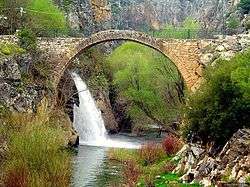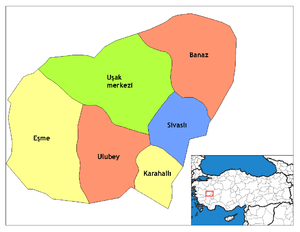Uşak
Uşak (Turkish pronunciation: [ˈuʃak]) is a city in the interior part of the Aegean Region of Turkey. The city has a population of 500,000 (2016 census) and is the capital of Uşak Province. The city was previously known by its Greek name of Ousakeion/Ουσάκειον.
Uşak | |
|---|---|
 Uşak | |
| Coordinates: 38°40′40″N 29°24′15″E | |
| Country | Turkey |
| Province | Uşak |
| Government | |
| • Mayor | Nurullah Cahan (AKP) |
| Area | |
| • District | 1,309.01 km2 (505.41 sq mi) |
| Population (600,000)[2] | |
| • Urban | 500,000 |
| • Density | 16/km2 (40/sq mi) |
| Website | www.usak.bel.tr |
Uşak city is situated at a distance of 210 km (130 mi) from İzmir, the region's principal metropolitan center and port city. Benefiting from its location at the crossroads of the Central Anatolian plateau and the coastal Aegean Region, and from a climate and agricultural production incorporating elements of both of these zones, Uşak has also traditionally had a strong industrial base. Uşak was the first city in Turkey to have an urban electricity network, and the first city where a collective labor relations agreement was signed, during the Ottoman era, between leather industry employees and workers. It was here that the first factory of Republican Turkey, a sugar refinery, was set up through a private sector initiative among local businessmen. The tradition of industriousness continues today around two industrial zones.
History

The first known organized states to have ruled over the region of present-day Uşak were the Phrygians in the eastern portion and the Lydians in the west during the seventh century BC. The Karun Treasure, discovered by clandestine treasure hunters in Uşak in 1965, and whose smuggling outside Turkey and subsequent retrieval decades later from New York City's Metropolitan Museum of Art made international headlines, gives an indication of the high degree of civilization attained by these Anatolian states. The region of Lydia was later taken over by the Persian Empire in the 6th century BC and by Alexander the Great and his successors as of the 4th century. Thereafter, Uşak was ruled successively by the Roman Empire, the Byzantine Empire, the Germiyanids and finally the Ottoman Empire (as of 1429).
Throughout classical times, until the Byzantine period, the city was called Ousakeion (Ουσάκειον) in Greek. Later, following Turkish conquest and domination over the area, the city became known by its Turkish name of Uşşak; which could mean "lovers" and "minstrels" simultaneously. Tradition privileges the second derivation, which could be a reference to the region's rich folk literature.
Uşak was occupied by the Greek army between 28 August 1920 and 1 September 1922. During the Greek retreat, Greek general Nikolaos Trikoupis was captured near Uşak at the village of Göğem, today buried under a dam reservoir.
Uşak was a district center within Kütahya Province until 1953, when Uşak Province was constituted and Uşak became its provincial capital.
Economic history
At least since the 17th century there was trade between Uşak and the Dutch republic as reflected in the rug shown thrown over the bannister in Vermeer's painting "The Procuress." The rug was probably produced in Uşak, covers a third of the painting and shows medaillons and leaves.[3]

In the early 20th century, mercury was discovered in Uşak.[5] The town also manufactured carpet.[6]
Among other district centers in Uşak Province, Banaz is the largest and is notable for its varied agricultural production as well as for its forests, while Ulubey's canyon is a natural site attracting many visitors.
Climate
Uşak has a hot summer mediterranean climate (Köppen climate classification: Dsa) with continental influences, with cold, wet and regularly snowy winters and hot, long and dry summers.
| Climate data for Uşak | |||||||||||||
|---|---|---|---|---|---|---|---|---|---|---|---|---|---|
| Month | Jan | Feb | Mar | Apr | May | Jun | Jul | Aug | Sep | Oct | Nov | Dec | Year |
| Average high °C (°F) | 7.2 (45.0) |
8.0 (46.4) |
12.0 (53.6) |
16.5 (61.7) |
21.9 (71.4) |
26.7 (80.1) |
30.5 (86.9) |
30.7 (87.3) |
26.3 (79.3) |
20.4 (68.7) |
13.8 (56.8) |
8.7 (47.7) |
18.6 (65.4) |
| Average low °C (°F) | −1.1 (30.0) |
−0.8 (30.6) |
1.5 (34.7) |
5.4 (41.7) |
9.3 (48.7) |
12.8 (55.0) |
15.8 (60.4) |
15.8 (60.4) |
11.9 (53.4) |
8.0 (46.4) |
3.5 (38.3) |
0.7 (33.3) |
6.9 (44.4) |
| Average precipitation mm (inches) | 63.1 (2.48) |
65.1 (2.56) |
55.3 (2.18) |
56.2 (2.21) |
44.9 (1.77) |
22.6 (0.89) |
18.1 (0.71) |
12.7 (0.50) |
17.7 (0.70) |
43.4 (1.71) |
65.4 (2.57) |
74.7 (2.94) |
539.2 (21.22) |
| Average rainy days | 11.6 | 10.8 | 10.4 | 11.2 | 9.9 | 5.1 | 3.1 | 2.3 | 3.5 | 6.9 | 8.5 | 12.0 | 95.3 |
| Mean monthly sunshine hours | 124 | 126 | 173.6 | 204 | 275.9 | 321 | 356.5 | 344.1 | 288 | 220.1 | 150 | 120.9 | 2,704.1 |
| Source: Devlet Meteoroloji İşleri Genel Müdürlüğü [7] | |||||||||||||
Uşak carpets
In pre-industrial times, Uşak was already a major center of production and export, particularly of Ushak carpets. Ushak carpets are also called Holbein carpets in reference to the 16th century painter Hans Holbein the Younger who depicted them in minute detail in his paintings, reflecting their popularity in European markets. The level of international popularity attained by Uşak's carpets became such that the word "Ushak" is considered an English word of Turkic origin.[8]
Although Uşak's carpet patterns have evolved since then, large-scale weaving still continues and the name of the city still has an important presence in the market for carpets, both hand-woven and industrial. On the other hand, the district of Eşme, which is also in Uşak Province, is famous for its kilims.
Twin cities



.svg.png)
See also
| Wikimedia Commons has media related to Uşak. |
References
- "Area of regions (including lakes), km²". Regional Statistics Database. Turkish Statistical Institute. 2002. Retrieved 2013-03-05.
- "Population of province/district centers and towns/villages by districts - 2012". Address Based Population Registration System (ABPRS) Database. Turkish Statistical Institute. Retrieved 2013-02-27.
- Onno Ydema (1991) Carpets and their Datings in Netherlandish Paintings, 1540 - 1700, p. 43, 44, 145. ISBN 90-6011-710-7
- Onno Ydema (1991) Carpets and their Datings in Netherlandish Paintings, 1540 - 1700, p. 43, 44, 145. ISBN 90-6011-710-7
- Prothero, G. W. (1920). Anatolia. London: H.M. Stationery Office. p. 106.
- Prothero, G.W. (1920). Anatolia. London: H.M. Stationery Office. p. 110.
- İl ve İlçelerimize Ait İstatistiki Veriler- Meteoroloji Genel Müdürlüğü Archived 2011-04-30 at the Wayback Machine
- Merriam-Webster Unabridged - Ushak A heavy woolen oriental rug tied in Ghiordes knots and characterized by bright primary colors and an elaborate medallion pattern.
